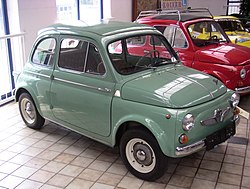Puch 500 (small car)
| Puch | |
|---|---|
|
Steyr-Puch 500 DL, built in 1961
|
|
| 500 | |
| Sales designation: | 500/500 S / 500 D / 500 DL / 650/650 T / 650 TR / 700 C / 700 E / 126 |
| Production period: | 1957-1975 |
| Class : | Microcar |
| Body versions : | Limousine , station wagon |
| Engines: |
Otto engines : 0.5–0.66 liters (12–30 kW) |
| Length: | 2970-3054 mm |
| Width: | 1320-1374 mm |
| Height: | 1302-1325 mm |
| Wheelbase : | 1840 mm |
| Empty weight : | 470-580 kg |

The Steyr-Puch 500 was a small car from the Puch-Werke (group company of Steyr-Daimler-Puch AG in Graz ). In Austria the car was popularly called Pucherl , in Styria it was also called Puchschammerl .
General
In 1957 the Steyr-Puch 500 model Fiat was introduced. For cost reasons, the company decided not to produce its own body and took over a body in white from the Fiat Nuova 500 . The air-cooled boxer engine with around 16 hp developed by Erich Ledwinka for this vehicle enabled good performance for the time, especially when driving uphill. The Steyr-Puch was clearly superior to the Fiat 500 with an in- line engine with the same fuel consumption and smoother running. The transmission, which was fully synchronized from the start, was also advanced and advantageous on mountainous roads. In the total braking area of the drum brakes , however, the Fiat exceeded the Steyr-Puch by 18%. The convertible sedan version of this model was primarily intended to appeal to motorcyclists as possible buyers.
The following models were produced:
| Type | Construction period | cylinder | Displacement | power |
|---|---|---|---|---|
| 500 | 1957-1959 | 2 boxers | 493 cc | 16 HP (12 kW) |
| 500 D | 1959-1967 | 2 boxers | 493 cc | 16 HP (12 kW) |
| 500 DL | 1959-1962 | 2 boxers | 493 cc | 20 HP (15 kW) |
| 700 C (station wagon) | 1960-1968 | 2 boxers | 643 cc | 25 HP (18 kW) |
| 700 E (station wagon) | 1962-1964 | 2 boxers | 643 cc | 20 HP (15 kW) |
| 650 T | 1962-1969 | 2 boxers | 643 cc | 20 HP (15 kW) |
| 650 TR | 1964-1966 / 69 | 2 boxers | 660 cc | 27/30 PS (20/22 kW) |
| 650 TR II | 1965-1969 | 2 boxers | 660 cc | 34/41 PS (25/30 kW) |
| 500 / S | 1968–1969 / 74 | 2 boxers | 493 cc | 16/20 PS (12/15 kW) |
| 126 | 1973-1975 | 2 boxers | 643 cc | 25 HP (18 kW) |
From 1959 the entire body including the roof was taken over by Fiat (Puch 500 D - like "roof"). For reasons of rationalization, from 1969 onwards, all of the technology, including the transmission, came from Fiat and only the engine from Puch. From 1973, the successor Fiat 126 was equipped with boxer engines instead of the Fiat Nuova 500 for a short time .
Only an engine cover of the prototype U3 still exists. This wooden model is in the Johann Puch Museum Graz
The sale of the small car was successful; of the almost 60,000 vehicles produced between 1957 and 1975, despite license clauses on the part of Fiat , many were also sold outside Austria, most of them to Germany; only one piece each went to Japan, Guatemala and the USA. The Finnish commercial vehicle manufacturer Suomen Autoteollisuus (who has also been involved in the import of cars for a long time) has imported small Steyr-Puch cars to Finland.
Motorsport
The type II TR 650 was in its time in the FIA - Group 2 bis 700 cm³ homologated and stronger estimate by the motor construction as the competition from the home Abarth . One of the highlights was the 1966 European Rally Championship title for Group 2 touring cars from Poland's Sobiesław Zasada .
Steyr-Puch 650 TR, built in 1964, at the DAMC 05 Oldtimer Festival Nürburgring
Collectibles and knickknacks
Knick-knacks , toys and everyday objects as a collection area are dominated by the Fiat Nuova 500 because - with almost the same body - it was on the market longer, achieved higher quantities and a greater range. Collectibles that can be clearly identified as Puch are all the more popular.
A few years after the 50th anniversary, a stamp with the Steyr-Puch 500 was issued ( first day : March 17, 2012)
Once a commodity, today a collector's item: a factory envelope with postmark dated July 31, 1973 from Salzburg
Popular culture
In some episodes of the Münsterland - Tatort films, the character Silke Haller played by Christine Urspruch drives a Puch 500.
Individual evidence
- ↑ Roland Russwurm: Austrian dictionary: at-de: Schammerl // cf. Puchschammerl - small car
- ↑ Steyr-Puch 500 . In: Motor Vehicle Technology 5/1958, pp. 179–180.
- ^ Auto-motor-und-sport: [1] Steyr-Puch 650 TR glory balls
- ↑ Steyr-Puch 500 D in "Tatort - Höllenfahrt". Retrieved March 10, 2019 .
Literature and Sources
- FF Ehn: The Puch automobiles 1900–1990. (2nd edition 2000).
- Franz Knogler: Steyr passenger car from 1920–1941. Steyr Daimler Puch AG, Steyr 1998, ISBN 3-9500823-1-X .
- Lauvray, Le Fay, Rybiczka: Fiat 500. HEEL Verlag, Königswinter, ISBN 978-3-89880-009-9 .
- Matthias Marschik, Martin Krusche: The history of the Steyr Puch 500 (world famous in Austria). Verlagshaus Hernals, 2012, ISBN 978-3-902744-55-5 .
- Egon Rudolf: Puch. A story of development. Weishaupt, Gnas 2007, ISBN 978-3-7059-0259-6 .
Web links
- Steyr Puch Club Austria / SPA
- The Steyr-Puch 500 and its cross-connections (documentation)
- Ani Reng: Styrian chamois . The story of becoming mobile between times. Date 6-7 / 2006, accessed June 19, 2010.















